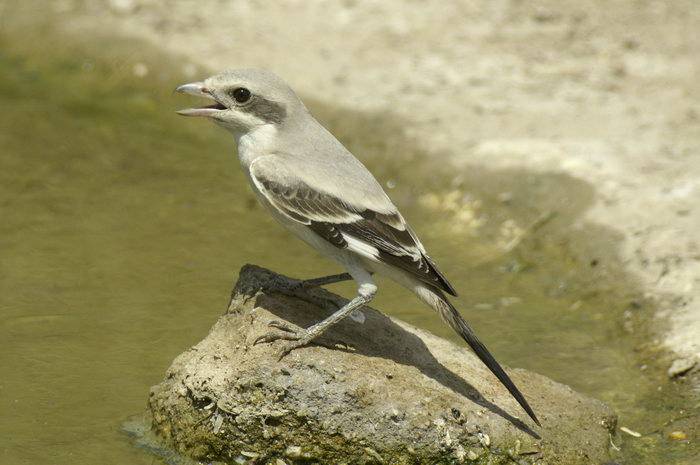
The taxonomy in del Hoyo, J and NJ Collar. 2014. HBW and BirdLife International Illustrated Checklist of the Birds of the World Volume 1: Non-passerines. (Lynx Edicions, Barcelona. 903 pages, hundreds of colour plates) employs the Tobias et al 2010 system of quantitative criteria for species delimitation (See on-line reference for free PDF). The Tobias system, which aimed to provide a working set of criteria that would improve consistency of conservation decision-making, on the face of it seems to offer useful insights, but nevertheless has drawn strong criticism for a variety of reasons, some of which are summarised below. The OSME Region List (ORL) largely follows the International Ornithological Congress World Bird List (currently v5.3 at http://www.worldbirdnames.org) as its general authority, but notes the progress of other approaches. As the above book reaches a wider audience, so the number of queries addressed to the ORL will rise on how the Tobias system will impact the ORL.
Since the publication of Tobias et al 2010, the ORL team has adopted a policy of ‘wait and see’ so that sufficient evidence of the Tobias system could accumulate to allow its robustness to be assessed. It is clear that in the intervening years a number of substantial criticisms of the Tobias system have arisen, but no rebuttal or amelioration by the authors has yet been published to our knowledge, very probably because they have stated since 2010 that they are intending to fine-tune the Tobias system based upon inputs from ornithologists, taxonomists and informed birdwatchers alike. However, the weight and import of some of the criticisms in our opinion demand a thorough response that probably will not occur in the short term, unfortunately. Our view is influenced largely by the comments of Remsen 2014 and Sangster 2015. At present, the robustness of the Tobias system criteria appears insufficient in its application beyond conservation decision-making, important though that is. Consequently, the ORL will note the taxonomic arrangement reached in the HBW/BirdLife Illustrated Checklist (including the passerine volume when published), making comment where deemed relevant, but will not adopt it. We illustrate one example of how DNA research can better inform understanding of taxa relationships here in an Appendix.
Our rationale
A number of problems have been identified with the Tobias criteria. The criticisms include:
- The exclusion of the rich source of phylogenetic information that is available from molecular studies.
- The lack of recognition that some morphological, acoustic or mensural data may for good reason not be phylogenetically informative.
- An unsophisticated approach to using data from hybrid zones.
- A lack of recognition that allopatric species-level taxa may for good reason display less morphological divergence than sympatric species.
- The calculation method has been criticised variously as arbitrary, subjective, simplistic, inappropriately calibrated, and wasteful of valuable data.
- It has also been argued that the authors have failed to define what they mean by “too many poorly defined species”, or to demonstrate that the criteria solve this perceived problem.
In summary, while we do not necessarily agree with all of these criticisms, their sheer number and variety from a multiplicity of specialists from quite diverse backgrounds give us good reason to be cautious in our consideration of the Tobias criteria. We also deem caution advisable given the lack of engagement with these criticisms to date by the authors of the Tobias criteria. The ORL attempts to reflect the latest understanding and interpretation, even though these may be incomplete, of the biological relationships between bird taxa.
Mike Blair[1], Steve Preddy, Richard Porter (The OSME Region List Team)
References
del Hoyo, J and NJ Collar. 2014. HBW and BirdLife International Illustrated Checklist of the Birds of the World Volume 1: Non-passerines. (Lynx Edicions, Barcelona. 903 pages, hundreds of colour plates)
Remsen, JV Jr. 2015. J Field Orn 86:182-187.
Review of: HBW and BirdLife International Illustrated Checklist of the Birds of the World Volume 1: Non-passerines. Josep del Hoyo and Nigel J. Collar 2014. Lynx Edicions, Barcelona. 903 pages,
Sangster, J. (Dutch Birding website 24 July 2015). Comments on the Tobias system employed in del Hoyo, J and NJ Collar 2014. (A formal paper will be published)
Tobias, JA, N Seddon, CN Spottiswoode, JD Pilgrim, LDC Fishpool and NJ Collar. 2010. Quantitative criteria for species delimitation. Ibis, doi: 10.1111/j.1474-919X.2010.01051.x. (http://www.zoo.ox.ac.uk/egi/wp-content/uploads/2012/03/Tobiasetal_Ibis2010.pdf).
[1] Listmaster, OSME Region List orl@osme.org
